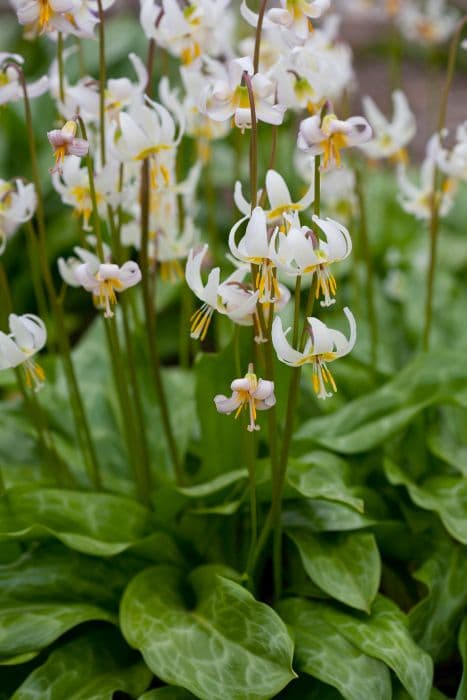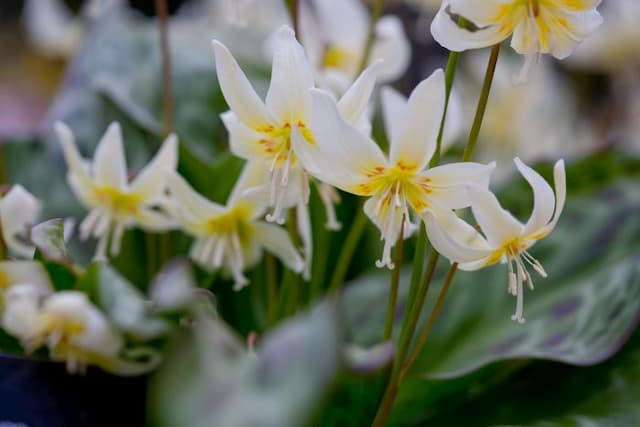Tulip Tulipa 'Garden Party' (3)

ABOUT
The Tulipa 'Garden Party', also commonly known as the Garden Party tulip, is a strikingly beautiful plant that gracefully thrives in the garden. The most arresting feature of this tulip is its blossoms, which exhibit a flamboyant display of colors. The flower petals are predominantly white, providing a crisp, clean backdrop for the delightful brush strokes of vibrant pink that adorn them. The pink hue, which can range from a soft pastel to a more assertive fuchsia, often appears as though it has been artfully painted onto each petal, resulting in a blushing effect that adds to its visual appeal. Embracing the center of the flower, the petals surround and protect the reproductive structures, inviting pollinators with their vivid colors. The blossoms are cup-shaped when fully open, creating a showcase that highlights the delicate interplay between white and pink. The brilliant green foliage of the Garden Party tulip offers a lush contrast to the colorful blossoms. The leaves are elongated and have smooth, clean edges, emanating from the base of the plant and providing a robust background for the dramatic flowers that sit atop sturdy, upright stems. The overall appearance of the Garden Party tulip is one of elegance and festive celebration, as if each bloom were dressed in its finest attire for a special occasion in the garden. The plant has a neat, clumping habit, with each individual tulip contributing to a collective display that can be nothing short of breathtaking in the right setting.
About this plant
 Names
NamesFamily
Liliaceae
Synonyms
Garden Party Tulip
Common names
Tulipa 'Garden Party'.
 Toxicity
ToxicityTo humans
Tulips, including the 'Garden Party' variety, can be toxic if ingested by humans. All parts of the tulip contain compounds that can cause irritation to the mouth and digestive system. Symptoms of tulip poisoning may include nausea, vomiting, diarrhea, and sometimes dizziness or palpitations if consumed in significant quantities. It is particularly important to make sure that children do not eat any part of the tulip plant.
To pets
Tulips, including the 'Garden Party' variety, are toxic to pets such as dogs and cats. All parts of the plant, especially the bulb, contain allergenic lactones and other compounds that can irritate the tissues if ingested. Symptoms of tulip poisoning in pets may include drooling, nausea, vomiting, and diarrhea. In severe cases, an increase in heart rate and difficulty breathing may be observed. If a pet consumes any part of a tulip, it should be considered a reason for concern and veterinary consultation is advised.
 Characteristics
CharacteristicsLife cycle
Perennials
Foliage type
Deciduous
Color of leaves
Green
Flower color
Mixed
Height
1-2 feet (30-60 cm)
Spread
4-6 inches (10-15 cm)
Plant type
Bulb
Hardiness zones
3
Native area
Asia Central
Benefits
 General Benefits
General Benefits- Ornamental Appeal: Tulips are widely appreciated for their unique shape and vibrant colors, which make them a popular choice for ornamental gardening.
- Spring Bloom: As a spring-flowering bulb, it contributes to the garden's bloom succession, providing color after the wintery months.
- Easy to Grow: Tulips are generally easy to cultivate, making them suitable for beginner gardeners and those looking for low-maintenance plants.
- Variety: A wide range of varieties, including 'Garden Party', offer a diversity of colors, shapes, and sizes for personalized garden design.
- Cut Flowers: Tulips are excellent for cut flower arrangements, with a vase life that allows enjoyment of their beauty indoors as well.
- Attract Pollinators: While primarily ornamental, tulips can attract pollinators like bees, aiding in garden biodiversity.
- Bulb Multiplication: Tulip bulbs can multiply underground, potentially providing additional plants over the years without the need for re-planting.
 Medical Properties
Medical PropertiesThis plant is not used for medical purposes.
 Air-purifying Qualities
Air-purifying QualitiesThis plant is not specifically known for air purifying qualities.
 Other Uses
Other Uses- Photographic subject: The distinctive patterns and colors of tulips, including the 'Garden Party', can make them excellent subjects for photography, allowing photographers to capture the intricate beauty of flowers as an artistic endeavor.
- Edible Garnish: Tulip petals, particularly from the 'Garden Party', can be used to add a colorful and slightly sweet garnish to salads and desserts, but should only be eaten if grown organically and confirmed to be free of harmful chemicals.
- Dye source: The pigments in 'Garden Party' tulip petals can be used to derive natural dyes for fabrics or crafting, giving materials a unique and organic hue.
- Eco-friendly confetti: Dried and crumbled petals of 'Garden Party' tulips can serve as a biodegradable alternative to traditional paper confetti for celebrations, reducing environmental impact.
- Floral water: By steeping 'Garden Party' tulip petals in water, one can create delicately scented floral water for use in home fragrance or as a gentle linen spray.
- Artistry and crafts: Pressed 'Garden Party' tulip petals can be used in art projects like scrapbooking, card making, or decoupage, offering a natural element to creative designs.
- Scented sachets: The petals and even bulbs of 'Garden Party' tulips can be dried and placed in cloth sachets to create natural air fresheners for drawers and closets.
- Learning tool for botany: 'Garden Party' tulips can be dissected and used in educational settings to teach students about plant biology and the anatomy of flowering plants.
- Ceremonial uses: In some cultures, 'Garden Party' tulips could be used in ceremonial decorations for events like weddings or festivals to symbolize love and happiness.
- Garden mulch: After tulips finish blooming, the foliage can be left to decompose in the garden, providing a natural mulch that can enrich the soil and suppress weeds.
Interesting Facts
 Feng Shui
Feng ShuiTulips are used in Feng Shui to bring positive energy and can be placed in the wealth area of a space to attract abundance or in the love and marriage area to enhance relationships.
 Zodiac Sign Compitability
Zodiac Sign CompitabilityTulips are not used in astrology practice.
 Plant Symbolism
Plant Symbolism- Perfect Love: The tulip, in general, is a symbol of perfect love, with this specific variety holding the same meaning due to its striking beauty and form.
- Declaration of Love: Giving a tulip, such as the 'Garden Party' variety, is seen as a declaration of one's love. Its appearance during spring can also symbolize a reawakening of emotions.
- Renewal and Rebirth: Since tulips are among the first flowers to bloom in spring, they represent renewal and rebirth, signaling the end of winter and the start of a fertile season.
- Prosperity: Historically, tulips, especially rare varieties like the 'Garden Party', were associated with wealth during the tulip mania, hence they can symbolize abundance and prosperity.
- Celebration: The name 'Garden Party' suggests a sense of festivity and joy, aligning with the tulip's association with celebrations, especially since they are often used in gardens and floral displays for special occasions.
 Water
WaterTulip 'Garden Party' generally requires moderate watering, especially during its growing season in the spring. They should be watered when the top inch of soil feels dry, usually about once or twice a week, depending on weather conditions. Avoid overwatering as tulips dislike excessive moisture. Slow, deep watering is recommended to encourage proper root growth, with about half a gallon per plant each time you water. After they bloom and enter dormancy, reduce watering gradually as the foliage begins to die back.
 Light
LightTulips prefer full sunlight to thrive, requiring at least six hours of direct sunlight per day. The best spot for Tulip 'Garden Party' is in an area that receives morning sunlight and is sheltered from the intense heat of the afternoon sun. However, they can tolerate partial shade, especially in hot climates, but bloom best with plenty of sunlight.
 Temperature
TemperatureTulips perform best in temperate climates with cool springs. For Tulip 'Garden Party', the ideal temperature range during the growing season is between 60 and 70 degrees Fahrenheit. They can survive winter temperatures well below freezing as long as they are planted at the correct depth in the fall, and they need a winter chill to bloom successfully. Temperature extremes above 70 degrees Fahrenheit during the growing season can impact bloom quality.
 Pruning
PruningTulip 'Garden Party' does not require traditional pruning but should be deadheaded after blooms have faded to prevent seed production and encourage the plant to store energy in the bulb for the next season. Foliage should be left to die back naturally and only removed when it has yellowed and withered, usually a few weeks after flowering. This allows nutrients to return to the bulb.
 Cleaning
CleaningAs needed
 Soil
SoilThe Tulip ‘Garden Party’ thrives in well-draining, fertile soil with a mixture of sandy or loamy components; a pH between 6.0 and 7.0 is ideal. Incorporate compost and peat moss into the soil to improve fertility and structure.
 Repotting
RepottingTulips, including the ‘Garden Party’ variety, are typically grown from bulbs that do not need to be repotted. After flowering, bulbs can be lifted and stored, then replanted in the fall.
 Humidity & Misting
Humidity & MistingThe ‘Garden Party’ Tulip prefers average outdoor humidity levels and does not require specific humidity adjustments when grown in its natural outdoor environment.
 Suitable locations
Suitable locationsIndoor
Place in bright, indirect light and keep soil moderately dry.
Outdoor
Plant bulbs in fall, full sun to partial shade, well-draining soil.
Hardiness zone
3-8 USDA
 Life cycle
Life cycleTulip 'Garden Party' begins its life cycle when a bulb is planted in well-drained soil during the fall before the onset of winter. As temperatures rise in spring, the bulb breaks dormancy and sprouts, sending up leaves and a single flowering stalk. The foliage photosynthesizes to gather energy, which is stored in the bulb for the next growing season. Once the flower blooms, it undergoes pollination, potentially with the assistance of insects, leading to the production of seeds. After flowering, the plant's above-ground parts die back, and the bulb goes into a period of dormancy during the hotter summer months. In the following fall, the cycle restarts as the bulb initiates the growth of new leaves and flowers, repeating the process.
 Propogation
PropogationPropogation time
Spring
Propogation: Tulipa 'Garden Party', commonly known as the tulip 'Garden Party', is most commonly propagated through bulb division. This is done after the leaves have died back at the end of the blooming season, typically in late summer or autumn. To propagate, carefully dig up the tulip bulbs and gently separate the smaller offset bulbs that have formed around the base of the mother bulb. These offsets are often referred to as bulblets and should be allowed to dry for a day or two before planting. They should be replanted at a depth of roughly three times the height of the bulb, with at least 4 to 6 inches (about 10 to 15 cm) of space between each bulb, in well-draining soil with full to partial sunlight. This method leverages the plant's natural reproductive cycle, ensuring genetic consistency and healthy new plants that will typically flower after one or two seasons of growth.








